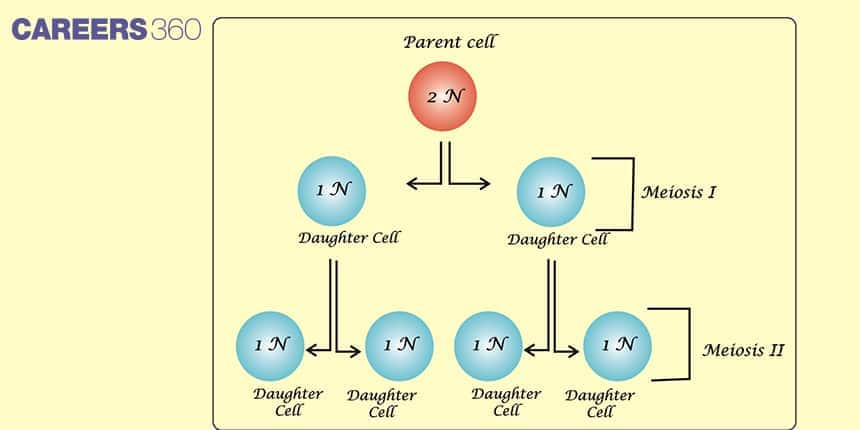Meiosis ll : Reduction Cell Division: Stages & Diagram
Meiosis II is the second division of meiosis, often called the equational division, as it maintains the chromosome number of the daughter cells. It resembles mitosis in many aspects. This stage ensures the formation of genetically distinct gametes, completing the process of sexual reproduction and contributing to genetic diversity.
This Story also Contains
- What is Meiosis II?
- Stages of Meiosis II
- Significance of Meiosis
- Meiosis II NEET MCQs (With Answers & Explanations)
- Recommended video on Meiosis II
.jpg)
What is Meiosis II?
Meiosis II refers to the second division in the process of meiosis, upon which sexual reproduction relies. In contrast to the first meiotic division that halved the number of chromosomes, in meiosis II equational division occurs, very much like a typical mitotic division. The sister chromatids of each chromosome are separated into two different cells. In this way, each of the four resulting haploid cells has a single set of chromosomes.
Stages of Meiosis II
The cells that enter meiosis II contain the haploid number of chromosomes. But these chromosomes still have duplicated sister chromatids. Therefore, the chromatids are reduced to one per chromosome during meiosis II
Prophase II
If the chromosomes decondense in telophase I, they condense again.
If nuclear envelopes are formed, they fragment into vesicles.
The centrosomes that were duplicated during interkinesis move away from each other toward opposite poles, and new spindles are formed.
Metaphase II
The sister chromatids are maximally condensed and aligned at the equator of the cell.
Anaphase II
The sister chromatids are pulled apart and move toward opposite poles.
Note that the chromatids of the chromosomes separate in this phase.
Telophase II and Cytokinesis
The chromosomes arrive at opposite poles and begin to decondense.
Nuclear envelopes form around the chromosomes.
Cytokinesis separates the two cells into four unique haploid cells.

Significance of Meiosis
Maintenance of Chromosome Number
Meiosis provides chromosomes from diploid to haploid so that when gametes fuse during fertilisation the correct number of chromosomes of the species is present in the zygote.
Genetic Diversity
It helps in introducing variations and mutation. It helps in doing research and learning about genetic disorders, and how mutation and variation in genes are passed on to the next generation.
Chromosomal Disorders
Errors in meiosis II can lead to genetic disorders in which the number of chromosomes is incorrect. Mostly this is aneuploidy, having more or fewer than 46 chromosomes. Chromosomal disorders can result in a range of developmental and health problems. For example, having an extra copy of chromosome 21 causes Down syndrome. Turner syndrome is a condition in which a female has only one X chromosome instead of two.
Meiosis II NEET MCQs (With Answers & Explanations)
Important topics for NEET exam are:
Stages of Meiosis II
Significance of Meiosis
Practice Questions for NEET
Q1. The significance of meiosis lies in
Reduction of the diploid number of chromosomes to haploid
Maintaining constancy in the number of diploid chromosomes during sexual reproduction
Production of genetic variability in the population of a species
All of these
Correct answer: 4) All of these
Explanation:
Meiosis II occurs in haploid cells where each chromosome still consists of duplicated sister chromatids, which are separated during this phase, resulting in haploid cells with single chromatids. The significance of meiosis lies in reducing the diploid chromosome number to haploid, ensuring constancy of chromosome numbers across generations during sexual reproduction, and generating genetic variability through crossing over and independent assortment. This variability plays a key role in evolution, while meiosis also enables the formation of haploid gametes (sperms and ova), essential for sexual reproduction in organisms.
Hence the correct answer is option 4) All of these.
Q2. During anaphase I, the _____ separate while during anaphase II _____ separate.
Chromatids, Homologous chromosomes
Homologous chromosomes, chromosomes
Homologous chromosomes, chromatids
None of these
Correct answer: 3) Homologous chromosomes, chromatids
Explanation:
To ensure that each daughter cell obtains one chromosome from each pair, homologous chromosomes are driven apart to opposing poles during anaphase I of meiosis. At their centromeres, the sister chromatids stay together. In anaphase II, analogous to mitosis, the sister chromatids are divided as the centromeres divide, with chromatids traveling to opposite poles. Four haploid cells with a single pair of chromosomes are produced as a result.
Hence, the correct option is 3) Homologous chromosomes, chromatids
Q3. Which of the following stages of meiosis involves the division of the centromere?
Metaphase I
Metaphase II
Anaphase II
Telophase II
Correct answer: 3) Anaphase II
Explanation:
Anaphase II begins with the simultaneous splitting of the centromere of each chromosome that allows them to move toward opposite poles of the cell. This makes sure that each of the daughter cells receives a haploid set of chromosomes, which contributes to genetic diversity and maintains the correct chromosome number in gametes.
Hence, the correct answer is option 3) Anaphase II.
Also Read:
Recommended video on Meiosis II
Frequently Asked Questions (FAQs)
Meiosis II separates sister chromatids into two cells, thus forming four haploid cells from an initial diploid cell.
Meiosis I separates homologous chromosomes, and decreases by half the number of chromosomes, and Meiosis II separates the sister chromatids but does not decrease further the number of chromosomes.
Meiosis II ensures genetic diversity and correct distribution of the chromosomes. It truly is necessary for healthy sexual reproduction and, for evolutionary adaptation.
Stages of Meiosis II are:
Prophase II
Metaphase II
Anaphase II
Telophase II followed by cytokinesis.
Errors such as nondisjunction can occur, leading to genetic disorders like Down syndrome and Turner syndrome due to abnormal chromosome numbers.